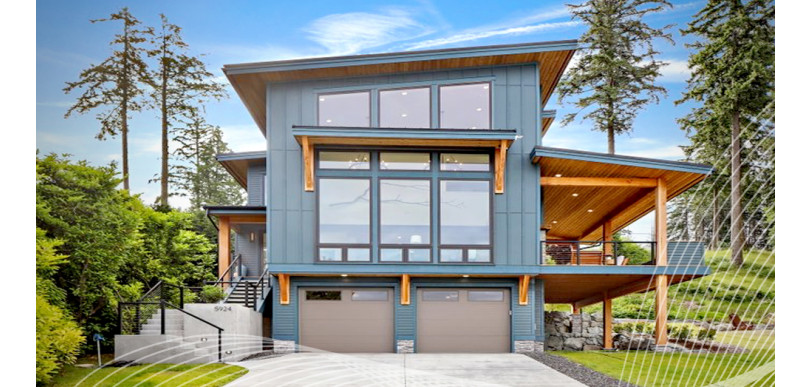When it comes to protecting your home from the elements, your roof does a lot of the heavy lifting. One of the most important—and often overlooked—factors in roof design is its slope. Whether you're planning a new build, replacing an old roof, or just curious, understanding how sloped roofs work can help you make smarter decisions for your home or business.
What Is a Sloped Roof?
In simple terms, a sloped or pitched roof is any roof that rises at an angle. The degree of that angle is called the roof pitch. Some roofs have a very steep pitch, while others are barely noticeable. Want to know your roof's pitch? You can figure it out with some basic measurements—or make it easier by using the Scope App Pitch Gauge Tool to measure pitch straight from your phone.
Roof Pitch Conversion Table
Understanding pitch measurements can be confusing if you're not used to working with roofing terms. Here's a handy conversion chart that shows how roof pitch (expressed as rise over run) translates to angles in degrees.
| Pitch (Rise/Run) | Angle (Degrees) |
|---|---|
| 1/12 | 4.76° |
| 2/12 | 9.46° |
| 3/12 | 14.04° |
| 4/12 | 18.43° |
| 5/12 | 22.62° |
| 6/12 | 26.57° |
| Pitch (Rise/Run) | Angle (Degrees) |
|---|---|
| 7/12 | 30.26° |
| 8/12 | 33.69° |
| 9/12 | 36.87° |
| 10/12 | 39.81° |
| 11/12 | 42.51° |
| 12/12 | 45.00° |
Use this chart to better understand your roof's slope and communicate clearly with your contractor or roofer.
Types of Sloped Roofs
Sloped roofs come in a variety of shapes and styles, each with its own pros and cons depending on your location, budget, and design preference. Here are a few of the most common types:
- Gable Roof: The classic triangle shape you see on many homes.
- Hip Roof: All sides slope down toward the walls, offering stability in windy areas.
- Mansard Roof: A French-style roof with four sides and a flat top, often adding attic space.
- Gambrel Roof: Think barn roofs—steep slopes with a flat upper section.
- Shed Roof: A single sloping plane, simple and modern.
Want to explore more options? Check out our full guide on 10 different roof types.
Why Sloped Roofs Are a Smart Choice
There’s a reason sloped roofs are so popular. They’re not just about looks—they’re designed to solve real problems. Here’s how:
- Better Drainage: Rain and snow slide off easily, helping prevent leaks and water damage.
- Energy Savings: A properly ventilated sloped roof can improve insulation and lower your energy bills.
- Durability: By allowing water to drain quickly, they reduce wear and tear, extending the life of your roof.
- Style and Space: Sloped roofs give your home character—and can even make room for an attic or vaulted ceilings.
- Fire Resistance: In some climates, the angle of a sloped roof can actually help slow the spread of fire upward from surrounding areas.
Sloped Roof vs. Flat Roof: What’s Right for You?
If you’re weighing the pros and cons between a sloped and flat roof, the biggest factor usually comes down to climate. Sloped roofs are ideal in areas with rain or snow because they shed water naturally. Flat roofs might be cheaper upfront, but they often require more maintenance over time. In contrast, sloped roofs offer better protection against pooling water, ice dams, and snow load, all of which can lead to structural problems if not addressed properly.
Best Materials for Sloped Roofs
Not all materials work the same on a pitched roof. Some of the best options include:
- Asphalt Shingles: Affordable, easy to install, and available in many styles.
- Metal Roofing: Lightweight, durable, and great for snow-heavy areas.
- Clay or Concrete Tiles: Ideal for warmer climates and Mediterranean-style homes.
- Wood Shakes or Slate: Natural materials that offer great aesthetics, though they require more maintenance.
- Composite Shingles: These mimic the look of slate or wood but require less upkeep and are lighter in weight.
How Roof Slope Impacts Drainage and Ventilation
The angle of your roof can make a big difference in how well your home manages moisture and airflow. A steeper slope helps direct rain and melting snow off the roof quickly, which means less risk of pooling and leaks. It also helps air move through your attic, improving overall ventilation. A well-ventilated roof system can also help prevent mold growth and ice damming, especially in cold climates. Want to brush up on other important roof elements? Take a look at our guide to the parts of the roof.
When to Consider a Sloped Roof
If you live in a region that gets a lot of rain, snow, or strong winds, a sloped roof is often the most practical solution. It’s also a good fit if you’re building a new home and want extra attic space or are planning to install solar panels. Keep in mind that local building codes and HOA regulations may also affect the minimum and maximum roof pitch allowed in your area—something to check with your contractor before finalizing your plans.
Need an Accurate Roof Measurement? We’ve Got You Covered.
Whether you’re starting from scratch or replacing an old roof, RoofScope provides ultra-accurate roof measurement reports using aerial imagery and CAD precision. Our easy-to-order reports help contractors and homeowners alike save time and avoid errors—no ladder required.
Final Thoughts
Sloped roofing offers more than just a timeless look. It’s a smart choice for protecting your home, managing the weather, and improving energy efficiency. If you're unsure about your current roof or planning a project, don’t guess—use our free Pitch Gauge App to check your slope and get started with confidence.
written by RoofScope published on 04. 14. 2025

